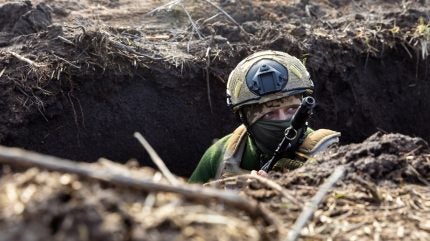
Three years on, Russia has gained the initiative over Ukraine – politically and militarily.
Invading Russian forces are making slow gains across Eastern Ukraine: Russian forces have lately levelled the frontline west of Kurakhove, where they have established more defensible positions.
Meanwhile, talks for a hurried peace settlement began in Saudi Arabia last week, which overtly sidelined Ukraine altogether, as Russia and the US vie over the future of the war-torn nation.
In accepting that Ukraine’s fate has fallen to the whims of foreign interests, then the belittled nation will need to strengthen its hand as much as possible on the ground.
In a panel discussion among security experts from the London-based Royal United Services Institute, days ahead of the conflict’s three-year mark (24 February 2025), Matthew Savill, the director of military sciences, noted that success for Ukraine depends on directing troop rotations on the frontline and depriving the Russian Air Force (VKS) of its stand-off strike capability.
Troop rotations
In the last year or so, it appears that Ukraine’s government has begun to lean more heavily on mobilisation: as demonstrated by the launch of recruitment and conscription apps such as Army+ and Reserve+, and subsequent efforts to update these digital platforms.
Towards the end of 2024, Ukrainian losses ranged between the low tens of thousands to in excess of 150,000. Overwhelmed by a much larger army, Ukraine is finding it difficult to plug holes in skills and manpower along the frontline where success is measured in yards.
“Though there are sufficient available people in the general Ukrainian population, the challenge that they face immediately is one of morale and then training to take raw recruits and turn them to into effective fighting forces, and then retain them by reducing desertion rates,” Savill observed.
“If there is a coordinated effort on equipping and training, particularly that rotates Ukrainian units off the line, reequips them, and brings them back up to strength,” he intimated, “they can continue to hold out this year.”
Ukraine has not been able to rotate troops as often as it would like, which has had a debilitating affect on morale. “It can be extremely mentally taxing to spend every day on the frontline,” noted the GlobalData defence analyst, Fox Walker.
“Extended periods in a high-intensity warfare environment can cause well-trained, well-equipped soldiers to make mistakes. The feeling that you will never return to ‘normal’ life until the war ends or you die can lead some soldiers to lose motivation,” Walker added.
VKS stand-off strikes
US approval for Ukraine to deploy long-range weapons inside Russian territory came too late in November 2024.
Glide bombs pose a formidable threat to Ukrainian strategic targets, fixed installations, and critical national infrastructure. A deep strike capability may be a potential, pre-emptive solution.
Russian forces use these pre-programmed, fixed-wing weapons from a distance, often from behind their own lines. The enemy has managed to get the range of some of these systems up to maybe 70 kilometres; they can launch glide bombs from an aircraft out of the range of Ukrainian air defences.
At present, Russia have an ongoing order for up to 70,000 glide bombs next year.
“So the best way [to deal with the threat], at the moment, is probably to directly target the air bases of the VKS and their fuel supplies, where they’re armed – essentially reduce the number of Russian Air Force sorties that can be launched,” Savill determined.
“Once they are in the air, if the aircraft are safe, the glide bomb itself is quite hard to detect and intercept, but not impossible. So the next step is, if you can’t hit the aircraft on the ground, and you can’t destroy their arms dumps, sensors and other detection networks can give you enough warning that you can effectively take the pre-emptive measures.”
Ukraine has already deployed its own, indigenous long-range capabilities inside Russia with limited success. Last year, the war-torn nation started producing its own sovereign deep strike weapon, which is a hybrid cruise missile and a long-range drone called the ‘Paliantsyia’.
“So the Ukrainian deep strike programme, if it can be ramped up against VKS targets, could really hurt them,” Savill asserted. “We have seen sabotage and other attacks in the past that actually got after Russian bombers and forced them to relocate literally thousands of kilometeres away to the other end of Russia. More of that could also help.”


